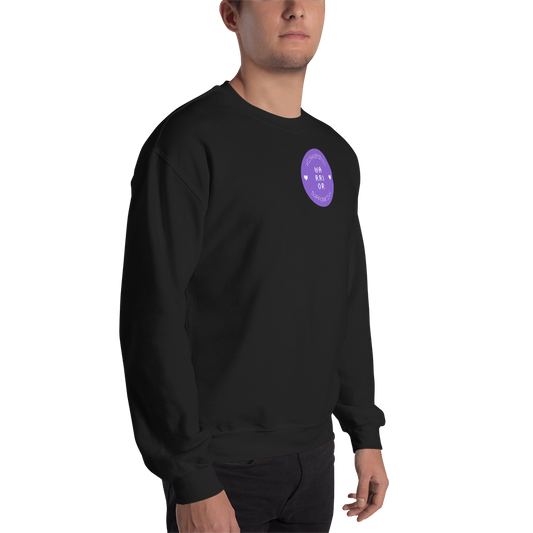Collection: Hidradenitis Suppurativa (HS) Awareness Sweatshirts & Hoodies for HS Warriors
-
I am an HS Warrior All Gender Comfy Sweatshirt
Regular price From $28.00 USDRegular priceUnit price / per -
I am an HS Warrior Awareness All Gender Premium Eco-Friendly Hoodie
Regular price From $60.00 USDRegular priceUnit price / per -
HS & HS Warrior "Dictionary" Definition Unisex Sweatshirt
Regular price From $28.00 USDRegular priceUnit price / per -
Hidraenitis Suppurativa (HS) Warrior Badge Unisex Sweatshirt
Regular price From $28.00 USDRegular priceUnit price / per -
HS & HS Warrior "Dictionary" Premium Eco-Friendly Hoodie
Regular price From $60.00 USDRegular priceUnit price / per
WTF IS HS HOPE CLUB?
FAQ's
What is HS Hope Club?
HS Hope Club is a small, women-owned, fellow HS Warrior business! 🌟 Your purchase is more than just an order; it's a pledge for hope an awareness for the HS community. 🌈 'Chronic but Iconic'—that's what you're helping us prove. 💜 And most importantly, Your support means the WORLD to this project! 🌍✨
Who is behind HS Hope Club?
Hi, it's me! 🙋🏽♀️ Ana Paola, an HS Warrior and advocate since 2011, now in remission, if you'd like to send me your story to get featured in the HS Warriors blog, send me an email to hello@hshopeclub.com
All sales are final! - What is Slow Fashion?
Slow fashion is about making thoughtful choices, valuing quality over quantity, and promoting sustainability. It aims to reduce waste and the environmental impact of fashion.
We believe in making a positive impact, both socially and environmentally. Our made-to-order approach minimizes waste and promotes ethical manufacturing.
All sales are final handled by Printful's awesome quality.
What is Hidradenitis Suppurativa?
As described in the American Academy of Dermatolofy Associatiom website:
Many people have never heard of hidradenitis suppurativa
During their first appointment with a dermatologist, patients with hidradenitis suppurativa (HS) often say they have pimples, sores, or lumps on their armpits or groin.
What is hidradenitis suppurativa?
Hidradenitis suppurativa (HS) is a skin condition that causes painful lumps deep in your skin. These lumps usually develop on parts of the body where skin touches skin like the armpits, inner thighs, and groin area. Dermatologists are the doctors who specialize in the diagnosis and treatment of this condition.
Is HS contagious? No
Many people live with HS for years before getting diagnosed
Also called acne inversa, HS can look like pimples and acne cysts. It’s not acne, though. Still, when HS first appears, some people think that they have pimples in their armpit, on their inner thighs, or in their groin area.
Without treatment for HS, this skin condition can worsen. Abscesses, which are pockets of pus, can develop. When an abscess breaks open, blood and pus leak out. As the abscess heals, a scar usually develops.
You may develop more abscesses in the same area. If the abscesses and scars continue to appear, tunnels can form under the skin. These pus-filled tunnels are called sinus tracts.
Getting medical treatment from a dermatologist before HS worsens can reduce flare-ups and prevent HS from becoming a painful disease that might cause disability.
Because you may not have heard of HS and HS can look like acne, boils, and sores, it can be difficult to know what to do. In fact, when seeing a dermatologist for the first time, many patients describe the reason for their visit as having one or more of the following:
- Armpit pimples or sores
- A lump or cyst in their underarm
- Pimples, cysts, lumps, or boils on their thigh
- Cysts on their groin
If you have any of these signs and have not seen a dermatologist, make an appointment. Dermatologists specialize in diagnosing and treating the skin and can tell you whether you have HS.
Many people live years with HS before being diagnosed. Years of having HS in the groin can cause trouble sitting or walking. Untreated HS in the armpits can make it difficult to reach for things. This happens when scars develop, which can limit how far you can stretch or bend.
People who go undiagnosed for years may live with intense pain. They can develop wounds that are slow to heal or fail to heal.
To get relief from the pain and care for their wounds, they often go to the emergency room (ER). According to a study conducted in Canada, some people return to the ER 10 or more times before getting diagnosed with HS. That’s why it’s important to see a board-certified dermatologist.
Hidradenitis suppurativa is:
● NOT a sexually transmitted disease
● NOT caused by unclean skin
● NOT contagious
● NOT acne
Is HS more common in Black people?
If you live in the United States and are an African American or biracial woman between 30 and 39 years of age, you have a higher risk of developing HS than do other Americans.
Research shows Black people develop this disease more often than people of other races. In a 2017 study, researchers found that for every 100,000 African Americans, 296 had HS.
Other studies have found that HS is more common in women than men. Research shows that at least three times as many women as men develop HS.
Can HS kill you?
HS can be painful. Without treatment, it can cause scars that make it difficult to move. However, HS is rarely life threatening. The only time HS might become life threatening is when someone develops a serious infection. Treatment and self-care for HS can help prevent a life-threatening infection.
Dermatologists are trained to recognize HS
To a dermatologist’s trained eye, there are differences between HS and other conditions like acne and boils. Dermatologists receive the training needed to spot these differences.
With an accurate diagnosis and proper treatment for HS, you can:
- Prevent HS from worsening
- Relieve pain
- Improve wound healing
- Treat an infection, which can develop if you have an open wound
Research has led to many treatment advances in recent years
Breakthroughs in HS research have led to a better understanding of this disease and better treatment for HS.
Today, many patients receive a treatment plan customized to their needs. A treatment plan may include:
- A skin care plan
- Medication
- A procedure that can be performed in your dermatologist’s office, such as draining or removing a painful lump
- Treatment for infection
- Wound care
- Pain control
- Self-care tips
Is there a cure for HS?
HS cannot be cured, but treatment can control the disease. Treatment can prevent new HS and treat existing HS. This means that HS does not have to stop you from living the life you want to live.
Why see a dermatologist?
Dermatologists are the doctors who usually diagnose and treat HS. When you see a dermatologist for HS, your dermatologist will create a treatment plan tailored to your needs and watch your health closely. People with HS have a higher risk for developing some health conditions, including arthritis, diabetes, and heart disease.
For this reason, dermatologists often work closely with other doctors. Doing so helps you get the care you need.
Your dermatologist can also watch for signs of skin cancer on your skin. Some people with HS have a higher risk of developing a common type of skin cancer called squamous cell carcinoma (SCC).
In people who have HS, this skin cancer tends to develop in unexpected places like around the anus or elsewhere in the groin area.
Dermatologists are skin cancer specialists, so they can spot signs of skin cancer early. Caught early, SCC is highly treatable.
What does HS look like?
If you think that you may have HS, you’ll find pictures of what it can look like and learn more about symptoms at: Hidradenitis suppurativa: Signs and symptoms.
Is Hidradenitis Suppurativa contagious?
No, Hidradenitis suppurativa is NOT:
● NOT a sexually transmitted disease
● NOT caused by unclean skin
● NOT contagious
● NOT acne
● NOT preventable
I've had bumps in my armpits before, could it be Hidradenitis Suppurativa?
How to Know if I Have Hidradenitis Suppurativa (HS)?
Diagnosis primarily relies on a clinical assessment. If you experience recurring painful nodules in areas like the armpits, groin, or buttocks, consult a healthcare provider. A delay in diagnosis can lead to a more severe form of the disease, affecting both your physical and emotional well-being.
Wondering if you might have HS? Grabd your pen and pencil, take this quick quiz to see if you should consult a healthcare provider for a clinical assessment. Remember, this quiz is not a substitute for professional medical advice.
Questions
- Do you experience recurring painful nodules or bumps in areas where your skin rubs together (e.g., armpits, groin, buttocks)?
- Have you noticed any skin abscesses that seem to come back in the same areas?
- Do you have tunnels or tracts under your skin that connect these nodules?
- Do these symptoms worsen during hormonal changes like menstruation?
- Have you tried over-the-counter treatments with little to no success?
Scoring
- 0-1 Yes: It's less likely that you have HS, but if you're concerned, consult a healthcare provider.
- 2-3 Yes: You should definitely consult a healthcare provider for a clinical assessment.
- 4-5 Yes: It's highly likely you have HS. Consult a healthcare provider as soon as possible for diagnosis and treatment options.
However, don't blame yourself, because you didn't cause your HS. While the exact cause of HS is still unknown, the immune system is believed to play a role in the symptoms you experience—like painful bumps and draining wounds. Keep in mind that HS can also be associated with other conditions, called comorbidities. That's why it’s important to partner with a doctor who has experience treating inflammatory diseases, and understands the history of HS.
Ana's Story with Hidradenitis Suppurativa
My name is Ana, and I'm an HS Warrior and the creator of HS HOPE CLUB. I'm a 34-year-old 💪🏻 living with Hidradenitis Suppurativa (HS) since the age of 11. 🙃
Like many of you, or perhaps your friends and family, I initially thought the bumps in my armpits were just a puberty thing or caused by a razor. Little did I know, my relationship with my armpits would never be the same. 😔
When I was around 15, the mental impact and social embarrassment from HS flare-ups started taking a toll on me. I remember the humiliation when a flare drained in the middle of my high school class. 👩🏫
I took it upon myself to research my symptoms online and discovered HS. I was hopeful about getting treated. However, the dermatologists we visited had little to no knowledge about the condition, even resorting to Googling it during consultations. 💔
Fast forward to age 34, with a healthy diet, exercise, and a lot of patience, I'm now in remission. 🌈 I still get flares, but they're more manageable than during my teenage years.
What I remember most is the loneliness and feeling misunderstood. 😢 That's why I created HS HOPE CLUB, a universe-themed blog 🌌. It's more than just a community; it's a cosmic connection of hope, healing, and exploration. 🌠
No matter where you are on this journey, remember that you're loved and worthy. 🌟 I'll be sharing posts in both English and Spanish 🇲🇽🇺🇸, so more of us can join the conversation. Your stories, insights, and presence make this community shine like the stars. 🌟
I'm excited to grow alongside you. Welcome to our community, and remember, we're all in this together. 🤝 Here's to a future filled with understanding, compassion, and infinite possibilities. 🌈
With cosmic love,
Ana 💜✨ #HSHopeClub #HSCommunity #HSWarrior










